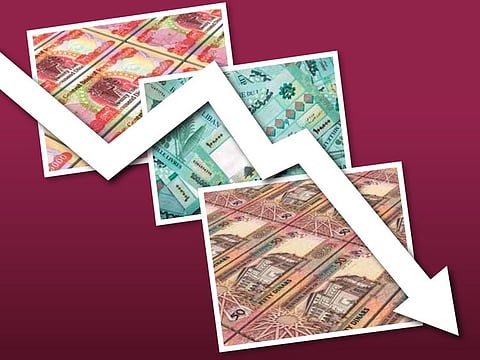Why are some currencies in Middle East under pressure?
Currency devaluation and inflation have become the scourge for countries in the region

If 2020 was the year of lockdowns to stem off the scourge of the Covid-19 pandemic and 2021 was dominated by mass vaccinations, PCRs, limited opening up of borders and interruption of supply chains, then 2022 was characterised by the Russia’s war with Ukraine, the rising concern about food security and the impending global recession. There are other crises that one can add to the list.
But as the world reopens slowly for business; removing obstacles to free travel and while the fear of the pandemic decreases a bit, although there are fresh concerns about a new strain originating from China, two major challenges will continue to haunt a number of countries in the region.
Both are related to the pandemic and to the war in Ukraine. They are inflation and currency devaluation.
This week the Egyptian currency made another historic plunge against the US dollar hitting a new low at 31 pounds. The pound has been suffering losses against the dollar for most of last year when the government, in a bid to stem the flight of foreign capital and to entice investors to calm down, decided to gradually float the pound.
To put things in perspective, in 2018 one US dollar would buy about 16 Egyptian pounds at the official rate of exchange. The local currency lost over 40 per cent against the dollar in 2022 alone.
Multifaceted economic woes
Of course Egypt’s economic problems are multifaceted. The war in Ukraine and the Covid-19 had exacerbated structural issues that had to do with internal and external borrowing, limitations on the role of the private sector and the legal environment. Needless to say that currency devaluation and rise of inflation will have a political cost.
Across the Mediterranean, Lebanon, once a haven for foreign deposits in under-regulated Lebanese banks that offered lucrative interest rates, now faces a huge liquidity problem and is unable to either pay its sovereign debts or give depositors their money.
The Lebanese lira has been in free fall since 2018 and inflation now hovers at more than 24 per cent while debt to GDP ratio sits at 170 per cent.
Much of the blame goes to the policy of Lebanon’s central bank, which had resorted to what is called “financial engineering” swapping public debt for Eurobonds in an attempt to postpone what had become the inevitable.
But while the central bank, faces flak, the real culprit is a corrupt political system that had allowed things to continue like this.
Bane of currency devaluation
Other countries facing the bane of currency devaluation and inflation include Syria, for obvious reasons and Iraq. In the latter’s case the Iraqi dinar has seen its value dropping against the dollar in recent weeks.
Hundreds of thousands of US dollars cross the border out of Iraq on a daily basis; mostly towards economically sanctioned Iran. But one can add financial mismanagement to that list. In a bid to introduce some reforms, Iraq’s central bank devalued the country’s currency in December 2020 hoping to control liquidity.
As if the Iraqi people had not gone through enough over the past three decades, now they face rising cost of living and an inflation rate of 6 per cent that is slated to go up as Iraq imports essential goods, including wheat, from abroad.
In Jordan, interest rates on loans have reached between 11 and 12 per cent, depending on the loan, thus sucking liquidity from the market and denying small to medium investors’ access to bank loans.
The country has recently suffered fuel crisis also. Under an IMF structural reform programme, fuel prices are adjusted monthly in line with global market fluctuations.
Public debt, inflation and currency fluctuations will feature as a major event for countries like Egypt, Tunis, Jordan, Iraq, Lebanon and Turkey in 2023 with socioeconomic repercussions and a hefty political cost. But each case is unique and while some countries will be able to overcome the storm others may have difficult times doing so.
Osama Al Sharif is a journalist and political commentator based in Amman.
Sign up for the Daily Briefing
Get the latest news and updates straight to your inbox


